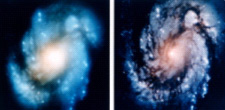Lessons Overview : Disdvantages of Radio Astronomy
Radio astronomy also has some disadvantages when compared to optical astronomy. Resolution, or the amount of clarity and detail an instrument can provide, is the area where radio astronomy has its largest disadvantage. The resolution of radio telescopes is extremely poor when compared to the resolution of optical telescopes. This is because radio wavelengths are much longer than visual wavelengths. A radio telescope must be 140,000 times the diameter of an optical telescope to achieve the same resolution! This is another reason that astronomers have turned to interferometry to make their observations.Another disadvantage of radio astronomy is radio pollution. In the same way that light pollution from highways, cities, and shopping malls makes optical astronomy more difficult, radio pollution from radio transmissions, television broadcasts and mobile communication devices masks some radio signals from natural sources. As human civilization continues to advance, both radio and optical observations become more difficult to make from Earth.
M100 as seen by the Hubble Space Telescope before and after repairs to improve resolution

NASA / STScI

NASA / STScI